Deductive reasoning test is among the most prevalent aptitude test for pre-employment assessment. Deductive reasoning test measures a candidate’s abilities to make logical deductions for problem-solving. Through the test, the candidates can usually demonstrate themselves to possess potential good qualities such as analytical thinking, good decision-making skill, and a problem-solving mindset.
Therefore, you need to thoroughly prepare for the deductive reasoning test, especially if you are aiming at a high-level management position. The better the result of the test is, the higher chance for you to be invited to the interview round.
In this article, we’ll give you a comprehensive guide on Deductive Reasoning tests, including their definition, question types, typical test providers, and a series of practice tests.
Table of Contents
What is a deductive reasoning test?
Deductive reasoning test is an aptitude test that aims to evaluate a candidate’s ability to make logical deductions – in other words, the ability to formulate a conclusion by analyzing, interpreting, and connecting the general facts and data.
Deductive Reasoning questions can be divided into three common types:
- Syllogism question: Determine whether a set of premises could lead to the given conclusions.
- Ordering and arrangement question: Order and arrange subjects into correct positions based on given conditions.
- Grouping question: Select, distribute, or categorize the subjects into groups based on certain conditions.
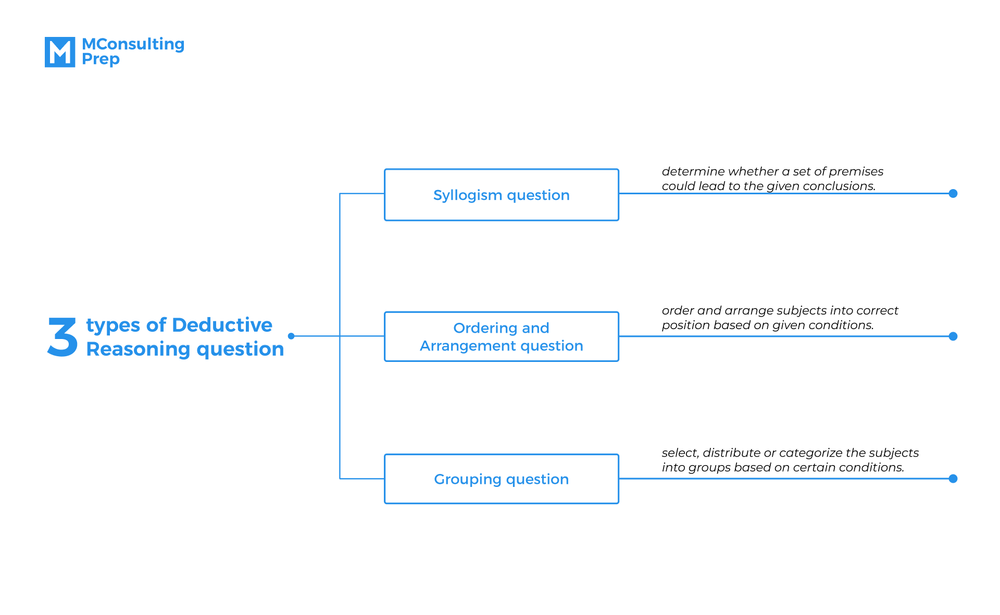
Companies and employers in various industries use psychometric tests to assess Deductive Reasoning skills (and Logical Reasoning skills) as this skill is fundamental to decision-making ability and analytical thinking skills. Most companies demand this as a core competence from all candidates, especially in managerial positions, which require a lot of strategic thinking and decision-making process.
Syllogism question
A syllogism question presents you with two or more general statements (premises), and specific conclusions. You must use logical deduction skills to determine whether the premises can lead to the provided conclusions. Syllogism question is one of the most classic question forms in deductive reasoning tests.
The format of syllogism questions consists of two parts:
- Premises is the first part – the ground rules and the relationships between the subjects.
- Conclusion(s) is the second part – the statement to be determined whether it can be derived from the premises using logical deductions. You could be asked to validate one to three conclusions or to choose the True/False conclusion among the given ones.

Source: MConsultingPrep
KEY TAKEAWAYS
A common strategy to approach this question type is to interpret the premises into a visualized logic model called Euler Diagram. This tool helps test takers easily spot the relationships among subjects and avoid choosing false conclusions (fallacy).
Here is an example of a syllogism question:
Statements:
Some berries are red.
Some grapes are green.
All grapes are berries.
Which conclusion is true based on the given statement?
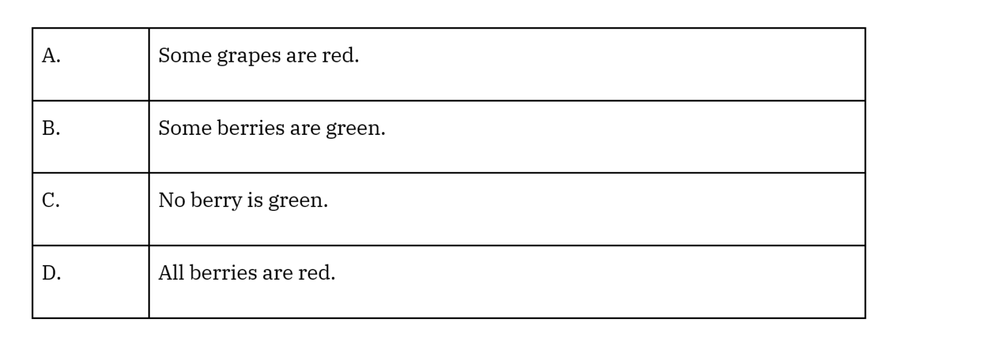
Denote:
~Br: Berries
~Grp: Grapes
~R: Red
~Grn: Green
1. Analyzing the statements:
Some berries are red. ⇒ Br ∩ R
Some grapes are green. ⇒ Grp ∩ Grn
All grapes are berries. ⇒ Grp ⊂ Br
Based on the above analysis, we can draw the Euler Diagram
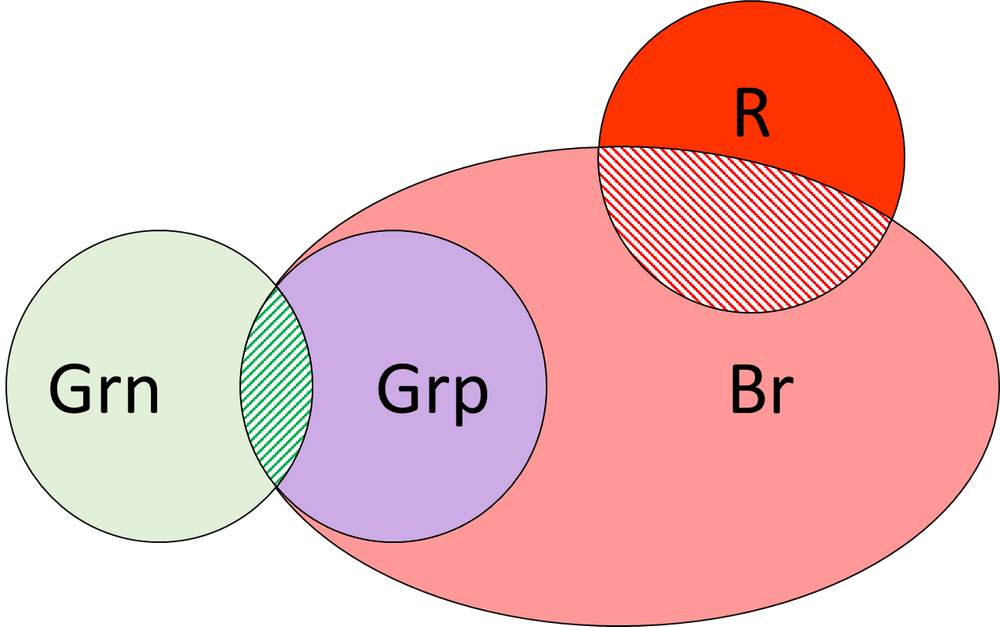
Guiding answer:
Some grapes are red. ⇒ Grp ∩ R
Based on the diagram, we can see that Grape and Red can either intersect with each other or not; therefore, we do not have enough information to reach this conclusion ⇒ Eliminate.
Some berries are green. ⇒ Br ∩ Grn
Based on the diagram, we can see that: a Grape is always a Berries; therefore, there are always some green grapes that are also berries ⇒ Conclusion is definitely true.
No berry is green. ⇒ Br ∩ Grn
Similarly, we can see that there are always some green grapes which are also berries ⇒ “No berry is green” can never happen ⇒ Conclusion is definitely false ⇒ Eliminate.
All berries are red. ⇒ Br ⊂ R
Based on the diagram, we can see that Berry and Red can either partly intersect with each other or include each other; therefore, we do not have enough information to reach this conclusion ⇒ Eliminate.
Ordering and arrangement question
Ordering and arrangement questions require you to use your logical deduction skills to order and arrange the subjects into their positions, then choose the correct answer based on the relational positions of the subject. Ordering and arrangement is the most common question type in deductive reasoning tests.
In this question type, all questions come with a scenario and a set of rules provided in the questions; however, the task to be done can be varied from multiple-choice format like most tests or in a gamified interactive format.
Ordering and arrangement questions can be divided into four sub-categories, which are:
- Seat arrangement
- Scheduling
- Ranking
- Blood Relations
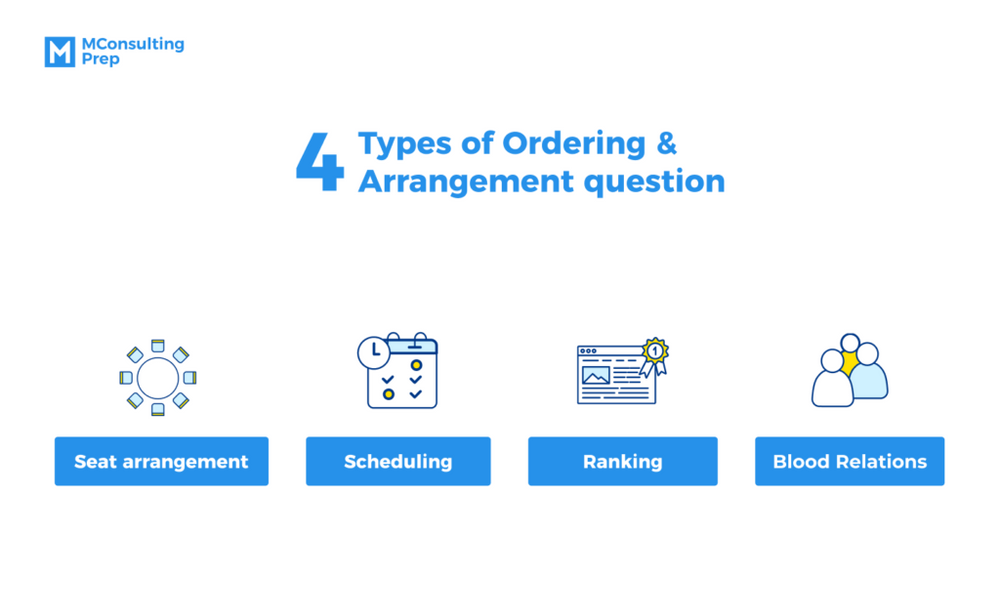
Now let’s dive deeper into each type of Ordering & Arrangement question.
Seat arrangement
Test takers are required to arrange subjects into positions in geometrical order(s). For some advanced questions, one may have to deal with multiple arrangements and/or some non-arrangement conditions.
To solve a seat arrangement question, test takers need to be able to identify and visualize the geometrical arrangement given in the questions. Then, they have to use logical deduction to transform the condition into relational positions of the subjects.
Here is an example of a seat arrangement question:

Source: MConsultingPrep
Five dishes – Biscuits, Curries, Frankie, Kababs, and Pasta are written in a row on the menu.
1. Biscuits is written next to Curries.
2. Frankie is written next to Kababs.
3. Kababs is neither to the immediate right nor to the immediate left of Pasta, which is on the left end of the menu.
4. Frankie is in the second position from the right.
5. Biscuits is to the right of Curries and Pasta.
6. Biscuits and Frankie are next to each other.
In which position Biscuits is written?
A. Between Curries and Kababs
B. Between Curries and Frankie
C. Between Pasta and Kababs
D. Between Frankie and Pasta
E. None of the above
Correct answer: B
Explanation:
From clue (1) and (2), we get two pairs of dishes:
[Biscuits-Curries]; [Frankie-Kababs]
From clue (3), we get the position of Pasta:
Pasta _ _ _ _
Kababs is neither to the immediate right nor to the immediate left of Pasta, then Kababs can be any position except for the first and second one.
From clue (4), we get the position of Frankie:
Pasta _ _ Frankie _
From clues (5) and (1), we get the positions of Biscuits and Curries:
Pasta Curries Biscuits Frankie _
The last empty position should be Kababs.
The final seating arrangement will be as follows (at the end of the page)
Therefore, Biscuits is between Curries and Frankie.
Scheduling
The tasks for this type are varied as follows:
- Find mutual time slot(s) for the subjects.
- Place the subjects on the timetable or calendar.
- Figure out the schedule of a specific subject.
KEY TAKEAWAYS
To solve a scheduling question, test takers must analyze the given conditions to place the subjects into suitable slots on the timetable or calendar. For the traditional multiple-choice test, you may need to draw the timetable on a piece of paper or in your mind. On the other hand, the interactive test will provide you with the timetable, so you only have to place the subjects in the correct positions.
Here is an example of a Scheduling question:

Source: MConsultingPrep
Question
Five dishes — A, B, C, D, and E, each of them is served on five different days from Monday to Friday, one after another, though not necessarily in the same order. Five dishes are served to five customers Archer, Brooks, Carter, Fletcher, and Graham. Further information is given as follows:
Archer is served with B but not on Thursday or Friday.
Brooks is served with A on Wednesday.
C or D are not served for Carter.
Carter is served on Monday.
Which of the following statements is TRUE?
A. Either C or E is served for Fletcher
B. D is served on Monday
C. E is served for Graham
D. D can be served for Graham
None of the above
Correct answer: D
Explanation:
We have three entities in the question:
- Names of dishes: A, B, C, D, and E
- Time frame from Monday to Friday
- Names of five customers: Archer, Brooks, Carter, Fletcher, and Graham
Using the four clues we get the following pairings:
[Archer — B — Not Thursday or Friday]
[Brooks — A — Wednesday]
[Carter —Not C or D — Monday]
This leaves Fletcher and Graham to be served with either C or D and either on Thursday or Friday.
Put them together to get the following arrangement:
Ranking
Ranking questions share certain similarities with seat arrangement questions – it is about putting the subjects in the right spot in a hierarchical order. The noticeable difference in this is that the question mainly concerns only the higher-to-lower type of arrangement. Therefore, it is easier to draw the base diagram than seat arrangement questions.
The solving steps of ranking questions are similar to seat arrangement – starting with drawing the ordering visualization, then interpreting the conditions to put the subjects in their correct positions.
Here is an example of a Ranking question

Source: MConsultingPrep
Question:
Paris, Manhattan, Nanno, Oswell, Quinn, and Langston are cousins. All of them have birthdays on the same date, but none of them is the same age.
(i) The youngest is 17 years old.
(ii) Quinn is the eldest and is 22 years old.
(iii) Langston is somewhere between Manhattan and Oswell in age.
(iv) Paris is elder to Manhattan.
(v) Nanno is older than Oswell.
If Nanno is 19 years old, which of the following must be FALSE?
A. Paris is 21 years old
B. Oswell is 18 years old
C. Nanno is a year older than Langston
D. Manhattan is three years older than Oswell
Correct answer: B
Explanation:
We will break down each premise and build a reaction tracker (the final result is at the end of the page)
(i) The youngest is 17 years old.
(ii) Quinn is the eldest
(iii) Langston is somewhere between Manhattan and Oswell in age.
⇒ Scenario 1: Manhattan < Langston < Oswell
⇒ Scenario 2: Oswell < Langston < Manhattan
(iv) Paris is elder to Manhattan.
⇒ Scenario 1: Manhattan < Langston < Oswell < Paris
⇒ Scenario 2: Oswell < Langston < Manhattan < Paris
(v) Nanno is older than Oswell.
Based on the reaction tracker, we can see that there can be only two people younger than Nanno ⇒ Scenario 1 is not plausible.
Since Nanno is 19 and older than Oswell, combined with Scenario 2, we have the complete reaction trackers as in the image
Based on the tracker, we can see that only the statement “Oswell is 18 years old” does not follow the results of reaction trackers.
Blood relations
The blood relations question, also known as the family-tree question, is the arrangement question based on people’s relationships in a family. A blood relations question can involve around 3 to 5 generations, and your task would normally identify the relationship between two people.
It is a complex type of ordering and arrangement question; therefore, it is used to determine the top-tier percentile of candidates (around 10-15%). On the bright side, this question type does not densely appear in the aptitude – so only if you aim to be in this percentile rank, should you practice this question type.
KEY TAKEAWAYS
The key to solving this type of question is that you need to know how to interpret the people’s relationships in the family tree – in particular, for each type of relationship, how should you place the people in the family tree accordingly.
To illustrate, let’s look at this example family tree
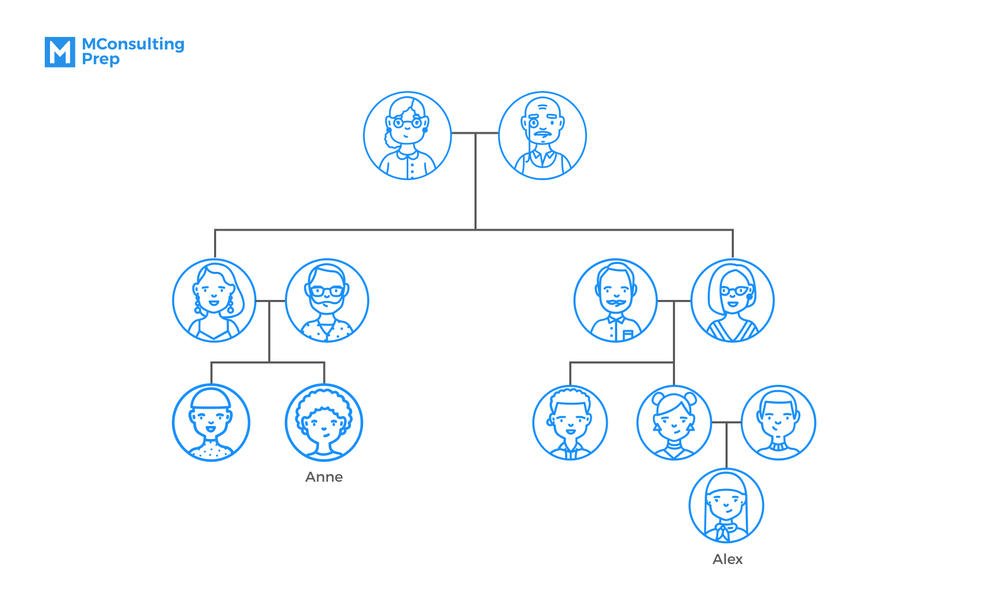
We have Anne and Alex. Alex is the fourth generation of the family, while Anne is the third generation. They belong to two separate branches of the family tree. Anne, therefore, is Alex’s (distant) aunt, and Alex is Anne’s (distant) niece/nephew.
Grouping question
In the Grouping question, you will be asked to select, divide or match the subjects into subgroups based on the given scenario and set of rules. You must choose the correct answer based on how the groups are formed or how the subjects are distributed into the sub-categories
Among the three common types of deductive questions, many different test providers use grouping less frequently. SHL is the test provider that still includes this type in their Deductive Reasoning Test; therefore, if you will have to take the SHL Test, grouping questions still needs the right amount of attention and preparation.
KEY TAKEAWAYS
To solve the grouping questions, you should follow these steps:
- Identify the groups/categories and their corresponding conditional statements.
- Draw a table/diagram to illustrate the groups
- Put each subject into the suitable group one by one using the given conditional statements.
- If there are multiple situations arise, draw different diagrams for each situation – then eliminate the situations that conflict with the given conditions.
Here is an example of a grouping question

Source: MConsultingPrep
Question:
A farmer wants to raise a hen, a cat, a dog, a bee colony, a goat, and a bear. There are three areas (A, B, C in order), and each can contain 2 creatures.
A bee colony cannot stay with anything
If an area has a dog, then there will be no cat
A goat must stay with the hen
A bear must stay 1 area away from the hen
The areas that don’t have the bee colony must contain 2 creatures
If the farmer keeps the bee colony and the hen if any of these animals are also chosen to stay, which one has no choice but to be in either area A or C?
A. Cat
B. Dog
C. Goat
D. Bear
E. Bee
Correct answer: D
Explanation:
If the Hen stays in B, the bear cannot stay, and every other animal must stay in either A or C, depending on the position of the bee colony.
If the Hen stays in either A or C, and the bees stay in B, every animal must stay in A or C.
If the Hen stays in either A or C and the bees don’t stay in B, every animal can stay in B, but the bear.
Therefore, in every case, the bear can only stay in either A or C, or not stay at all.
Two essential skills to crack deductive reasoning test
To ace your deductive reasoning test, you need to practice them in advance. There are two basic skills to practice for the deductive reasoning test.
Skill 1: Make a diagrammatic logic model from the question
This is one of the fundamental skills to solve Deductive Reasoning puzzles.. For this skill, you must be able to follow these steps:
- Identify the question types to determine which strategies to approach the questions
- Identify the subjects and the set of rules that defines their relationships.
- Separately interpret each premise (or condition) into the correspondent logic model(s). DO NOT ATTEMPT TO SOLVE ALL PREMISES/CONDITIONS AT ONCE. Each condition/premise has different logic models, so you should look into each question and figure out their logic model.
Skill 2: Interpret the diagram to identify the subjects’ relationship
Using the similar logic that you use to build the diagram, you can now examine each choice of the questions, following these steps:
- Identify the subjects to be examined in the diagram
- Look at their position on the diagram and name the correspondent relationship to them
- Cross-check with the choice given in the question to determine whether it is true or false
For different test providers, the questions could have either ONLY ONE correct answer or multiple correct answers. In addition, for a scenario and set of conditions, the number of questions can range from one to three.
Note: All initial rules or conditions are applied to all the questions given after that. However, sometimes a particular question might introduce new input. Hence, students are expected to consider each question separately from the other questions.
Common test providers
Deductive reasoning exists in different kinds of tests – it can be an independent deductive reasoning test, a general logical reasoning test, or be assessed through other skills tests such as verbal reasoning or numerical reasoning. Here are some of the most popular test providers for the deductive reasoning test.
SHL
SHL is one of the most prominent pre-employment test providers in the market. SHL Deductive Reasoning comes in two types of types: SHL Standard Multiple Choice and SHL Interactive Verify Test.
- SHL Standard Multiple Choice: This test format consists of 18 multiple-choice questions and lasts for 20 minutes. The question ranges from syllogism, ordering & arrangement, and grouping.
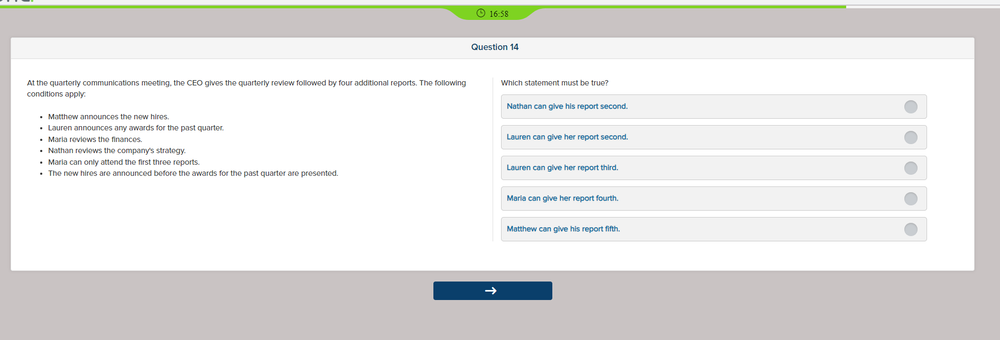
Scheduling question from SHL Deductive Reasoning test (Standard Multiple-choice)
- SHL Interactive Verify Test: The test is an innovative way to make the assessment process more engaging. It lasts for 12 minutes and contains 18 interactive questions. Candidates will have to drag, drop, and click on the objects to schedule on a calendar. place rankings based on the given condition or give more.
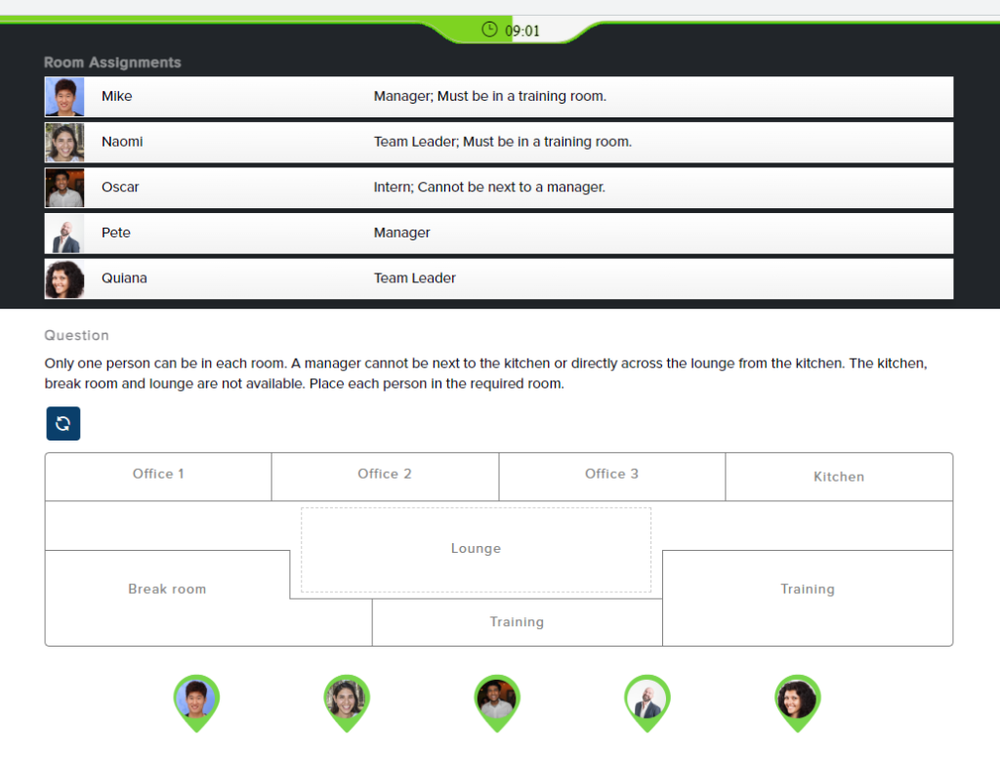
Seat arrangement question from SHL Deductive Reasoning test (Interactive Verify)
Talogy (formerly known as CUBIKs)
Talogy (Cubiks) was established in 1946 with the mission of using assessments to help young adults join the workforce after a period of work turmoil. Throughout its 70-year history, Talogy has helped to solve talent challenges for numerous companies worldwide.
Talogy does not have a separate test for Deductive Reasoning – this skill is tested in the Verbal Section of the Intermediate CUBIKs test. The intermediate version has 24 questions in 4 minutes, mixing word analogy, syllogism, and short reading comprehension questions.
Here is an example of a Syllogism question in the test

Syllogism question from the Verbal Section of CUBIK – LOGIK Intermediate Test
Kenexa
Kenexa, a child company of IBM, offers employment and retention services. This covers recruitment process outsourcing onboarding tools, employee assessment, abilities assessment for potential candidates, and Kenexa Interview Builder.
The IBM Kenexa Deductive Reasoning test contains 20 questions – all in the form of seat arrangement questions. The test is untimed; however, you still need to finish the test in the shortest time possible since the completion time will be recorded and considered during the recruitment process.
Key tips to pass the deductive reasoning test
Practice with various types of questions
A deductive reasoning test covers a lot of different question types, as mentioned above. Each type has a different solving approach. Therefore, not only should you know how to solve every type of question, but you also have to be familiar with them as well, especially when you are not sure which test providers you would take the test from.
Our Deductive Reasoning Test Package includes over 240 questions that cover all of the common question types: Syllogism, Order & Arrangement, and Grouping.
One minute on one question only
A deductive reasoning test requires one person to apply logic models to make sense of the question; nonetheless, to visualize complex logic models while analyzing the questions under time pressure could be dreadful. You should always bring a pen and a note (at least a draft paper) to draw and note down the diagram and information about the question. In this way, your mind is relieved and focuses more on the process of solving a Deductive Reasoning question.
Apply deductive reasoning in real life
A deductive reasoning test could be a tool for employers to assess your ability, but at the end of the day, what an employer looks for is how you use deductive reasoning in a real work situation. Start with solving your daily issues with fact-based analysis. From scheduling a dinner out with your loved one on a busy week or which new iPhone is suitable for you – there is a lot of space to practice deductive reasoning.
Example: If you want to choose whether to buy an iPhone 13 or an iPhone 14, firstly, you would need to establish a set of conditions (or your criteria) for choosing a phone (e.g.: the features, the price, the color, etc.), then you match the characteristics of each phone to the set of conditions to see which one have more matches. This process is how you make logical deductions to reach a conclusion.
/filters:quality(75)//case_thumb/public/1699589977462_aptitude_tests_package_4_x.png)